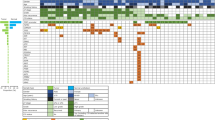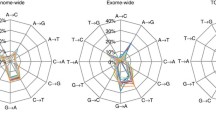Abstract
Recent investigations have demonstrated p53 and Rb alterations in a subset of transitional cell carcinoma (TCC). Further genetic changes during tumor progression include overexpression of the c-myc gene in a significant number of mainly invasive bladder tumors. To study the possible interactions between these genes in TCC, urothelial cancer cell lines were chosen as an in vitro model. Expression and mutation of p53 was studied in 15 bladder cancer cell lines by immunocytochemistry, Western blot, polymerase chain reaction single-strand conformation polymorphism (PCR-SSCP) analysis and direct sequencing of double stranded PCR products of exons 4, 5, 7 and 8 of genomic DNA. C-myc expression and gene structure were studied using Northern and Southern blot techniques. Rb protein expression was analyzed by Western blot. Twelve of 15 cell lines showed either p53 mutations or abnormal protein expression. Consistent with previous studies, five cell lines did not express Rb protein. None of the cell lines studied retained both tumor suppressor genes in a functional form. The c-myc gene appeared to be intact in all cell lines and copy numbers were close to normal. Northern analysis demonstrated that all cell lines expressed c-myc mRNA but evidence for altered regulation was found in at least two cell lines. Our data suggest that amplification or translocation are not the underlying mechanism for c-myc overexpression in urothelial tumors. No correlation between loss of Rb protein and c-myc expression was observed. The results presented here for the cell lines match well those obtained in vivo. Thus, these cell lines may provide a suitable model for further analysis of molecular alterations in urothelial cancer.
Similar content being viewed by others

References
Banks L, Matlashewski G, Crawford L (1986) Isolation of human-p53-specific monoclonal antibodies and their use in the studies of human p53 expression. Eur J Biochem 159:529
Bernard O, Cory S, Gerondakis S, Webb E, Adams JM (1983) Sequences of the murine and human cellular myc oncogene and two modes of myc transcription resulting from chromosome translocation in B lymphoid tumors. EMBO J 2:2375
Chomczynski P, Sacchi N (1987) Single-step method of RNA isolation by acid guanidinium thiocyanate-phenol-chloroform extraction. Anal Biochem 162:156
Cobrinik D, Dowdy SF, Hinds PW, Mittnacht S, Weinberg RA (1992) The retinoblastoma protein and the regulation of cell cycling. TIBS 17:312
Cordon-Cardo C, Dalbagni G, Saez GT, Oliva MR, Zhang Z-F, Rosai J, Reuter VE, Pellicer A (1994) p53 mutations in human bladder cancer: genotypic versus phenotypic patterns. Int J Cancer 56:347
Eickelmann P, Ebert T, Warskulat U, Schulz WA, Sies H (1993) Expression of NAD(P)H: quinone oxidoreductase and glutathione S-transferases Alpha and Pi in human renal cell carcinoma and in kidney cancer-derived cell lines. Carcinogenesis 15:219
Fujimoto K, Yamada Y, Okajima E, Kakzioe T, Sasaki H, Sugimura T, Terada M (1992) Frequent association of p53 gene mutations in invasive bladder cancer. Cancer Res 52:1393
Habuchi T, Ogawa O, Kakehi Y, Ogura K, Koshiba M, Sugiyama T, Yoshida O (1992) Allelic loss of chromosome 17p in urothelial cancer: strong association with invasive phenotype. J Urol 148:1595
Hamel PA, Gill RM, Phillips RA, Gallie BL (1992) Transcriptional repression of the E2-containing promoters EIIaE, c-myc, and RB1 by the product of the RB1 gene. Mol Cell Biol 12:3431
Hartl P, Lipp M (1987) Generation of a variant t(2;8) translocation of Burkitts's lymphoma by site-specific recombination via the kappa light-chain joining signals. Mol Cell Biol 7:2037
Hollstein M, Sidransky D, Vogelstein B, Harris CC (1991) p53 mutations in human cancers. Science 253:49
Horowitz JM, Park S-H, Bogenmann E, Cheng J-C, Yandell DW, Kaye FJ, Minna JD, Dryja TP, Weinberg RA (1990) Frequent inactivation of the retinoblastoma anti-oncogene is restricted to a subset of human tumor cells. Proc Natl Acad Sci USA 87:2775
Kyhse-Andersen J (1984) Electroblotting of multiple gels: a simple apparatus without buffer tank for rapid transfer of proteins from polyacrylamide to nitrocellulose. J Biochem Biophys Methods 10:203
Lane DP (1992) p53, guardian of the genome Nature 358:15
Lane DP, Benchimol S (1990) p53: oncogene or anti-oncogene? Genes Dev 4:1
Lane RD, Federman D, Flora JL, Beck BL (1986) Computerassisted determination of protein concentrations from dyebinding and bicinchoninic acid protein assays performed in microtiter plates. J Immunol Methods 92:261
Marcu KB, Bossone SA, Patel AJ (1992) myc function and regulation. Ann Rev Biochem 61:809
Masters JRW, Hepburn PJ, Walker L, Highman WJ, Trejdosiewicz LK, Povey S, Parkar M, Hill BT, Riddle PR, Franks LM (1986) Tissue culture model of transitional cell carcinoma: characterization of twenty-two human urothelial cell lines. Cancer Res 46:3630
Meichle A, Philipp A, Eilers M (1992) The functions of Myc proteins. Biochim Biophys Acta 1114:129
Moberg KH, Tyndall WA, Hall DJ (1992) Wild-type murine p53 represses transcription from the murine c-myc promotor in a human glial cell line. J Cell Biochem 49:208
Momand J, Zambetti GP, Olson DC, George DL, Levine AJ (1992) The mdm-2 oncogene product forms a compex with the p53 protein and inhibits p53-mediated transactivation. Cell 69:1237
Montenarh M (1992) Biochemical properties of the growth suppressor/oncoprotein p53. Oncogene 7:1673
Orita M, Suzuki Y, Sekiya T, Hayashi K (1989) Rapid and sensitive detection of point mutations and DNA polymorphisms using the polymerase chain reaction. Genomics 5:874
Pietenpol JR, Munger K, Howley PM, Stein RW, Moses HL (1991) Factor-binding element in the human c-myc promotor involved in transcriptional regulation by transforming growth factor β1 and by the retinoblastoma gene product. Proc Natl Acad Sci USA 88:10227
Plumb M, Stein J, Stein G (1983) Coordinate regulation of multiple histone mRNAs during the cell cycle in HeLa cells. Nucl Acids Res 11:2391
Presti JC, Reuter VE, Galan T, Fair WR, Cordon-Cardo C (1990) Molecular genetic alterations in superficial and locally advanced human bladder cancer. Cancer Res 51:5405
Reddy EP, Reynolds RK, Santos E, Barbacid M (1982) A point mutation is responsible for the acquisition of transforming properties by the T24 bladder carcinoma oncogene. Nature 300:149
Sambrook J, Fritsch EF, Maniatis T (1989) Molecular cloning: a guide to methods and applications. Cold Spring Harbour, New York
Schmid P, Schulz WA, Hameister H (1989) Dynamic expression pattern of the myc protooncogene in mid-gestation mouse embryos. Science 243:226
Schmitz-Dräger BJ, van Roeyen CRC, Grimm M-O, Gerharz C-D, Decken K, Schulz WA, Bültel H, Makri D, Ebert T, Ackermann R (1994) p53 accumulation in precursor lesions and early stages of bladder cancer. World J Urol 12:79
Schmitz-Dräger BJ, van Roeyen CRC, Gerharz C-D, Decken K, Bültel H, Schulz WA, Grimm M-O, Ebert T, Ackermann R (1994) p53 and c-myc during development and progression of bladder cancer. Eur Urol (submitted for publication)
Schwarz K, Hansen-Hagge T, Bartram C (1990) Improved yields of long PCR products using gene 32 protein. Nucl Acids Res 18:1079
Shaulsky G, Goldfinger N, Tosky MS, Levine AJ, Rotter V (1991) Nuclear localization is essential for the activity of p53 protein. Oncogene 6:2055
Soussi T, de Fromentel CC, May P (1990) Structural aspects of the p53 protein in relation to gene evolution. Oncogene 5:945
Spencer CA, Groudine M (1991) Control of c-myc regulation in normal and neoplastic cells. Adv Cancer Res 56:1
Spruck CH III, Ohneseit PF, Gonzalez-Zulueta M, Esrig D, Miyao N, Tsai YC, Lerner SP, Schmütte C, Yang AS, Cote R, Dubeau L, Nichols PW, Hermann GG, Steven K, Horn T, Skinner DG, Jones PA (1994) Two molecular pathways in transitional cell carcinoma of the bladder. Cancer Res 54:784
Tabin CJ, Bradley SM, Bargmann CI, Weinberg RA, Papageorge AG, Scolnick EM, Dhar R, Lowy DR, Change EH (1982) Mechanism of activation of a human oncogene. Nature 300:143
Takahashi R, Hashimoto T, Xu H-J, Hu S-X, Matsui T, Miki T, Bigo-Marshall H, Aaronson SA, Benedict WF (1991) The retinoblastoma gene functions as a growth and tumor suppressor in human bladder carcinoma cells. Proc Natl Acad Sci USA 88:5257
Tsai YC, Nichols PW, Hiti AL, Williams Z, Skinner DG, Jones PA (1990) Allelic loss of chromosome 9,11, and 17 in human bladder cancer. Cancer Res 50:44
Tso JY, Sun XH, Kao TH, Reece KS, Wu R (1985) Isolation and characterization of rat and human glyceraldehyde-3-phosphate dehydrogenase cDNAs: genomic complexity and molecular evolution of the gene. Nucl Acids Res 13:2485
Vogelstein B, Kinzler KW (1992) p53 function and dysfunction Cell 70:523
Williams RD (1980) Human urologic cancer cell lines. Invest Urol 17:359
Author information
Authors and Affiliations
Rights and permissions
About this article
Cite this article
Grimm, MO., Jürgens, B., Schulz, W.A. et al. Inactivation of tumor suppressor genes and deregulation of the c-myc gene in urothelial cancer cell lines. Urol. Res. 23, 293–300 (1995). https://doi.org/10.1007/BF00300017
Received:
Accepted:
Issue Date:
DOI: https://doi.org/10.1007/BF00300017



